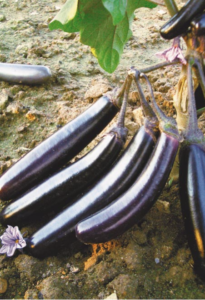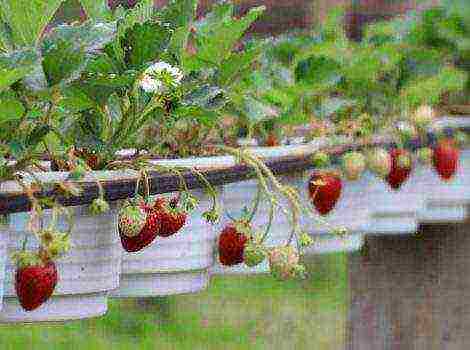Content
- 1 Beretsky
- 2 Anzherskaya
- 3 An excellent pupil
- 4 Golden
- 5 Crimean early
- 6 Kuban yielding
- 7 Muscat
- 8 Rumo
- 9 Kaunchi-10
- 10 Teplovskaya
- 11 Video review of quince, harvesting
- 12 Ay yes quince
- 13 Favorite varieties
- 14 Classification of varieties
- 15 The most common varieties of quince
- 16 What a quince looks like: a photo and description of the species and varieties of shrubs
- 17 How to grow quince and how to care for it
- 18 Care and growing of quince: pruning and propagation by cuttings (with photo)
- 19 Why is quince useful for the body and how to use it
Quince is a plant belonging to the Rosaceae family. Reaches a height of 7-9 meters. The beneficial properties of tart fruits have been known since antiquity. Some historians claim that it was the quince that was the apple, with the inscription "fairest", which Aphrodite received as a result. Lemon yellow fruits are prized for their pleasant aroma and sweet and sour taste. Quince is a great addition to meat dishes; it makes good compote, jam and preserves.
Experts divide the quince into 5 main groups, including about 400 varieties. Garden groups differ in leaf color, crown shape and fruit. Do you want to plant quince on your site, but do not know which variety to give preference to? This article presents the best of the best that deserve attention first.
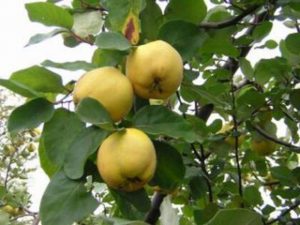 Beretsky
Beretsky
The variety was bred in Hungary. The trees are tall. The crown is pyramidal. The fruits are large, pear-shaped, weighing 250-270 grams. Sometimes there are specimens of 350-400 gr. They ripen in October. Its characteristic feature is its thin skin. It is noteworthy that the quince does not crumble when ripe. Stored without losing its original appearance and taste for 80 days. The tree begins to bear fruit at 2-4 years of age.
Anzherskaya
Early ripening, obtained in France. Quince is shaped like apples. The skin is smooth, yellow. The pulp is firm, granular in the middle. The variety attracts with fast ripening, high yield and resistance to fungal diseases. Angerskaya quince is stored for up to 60 days.
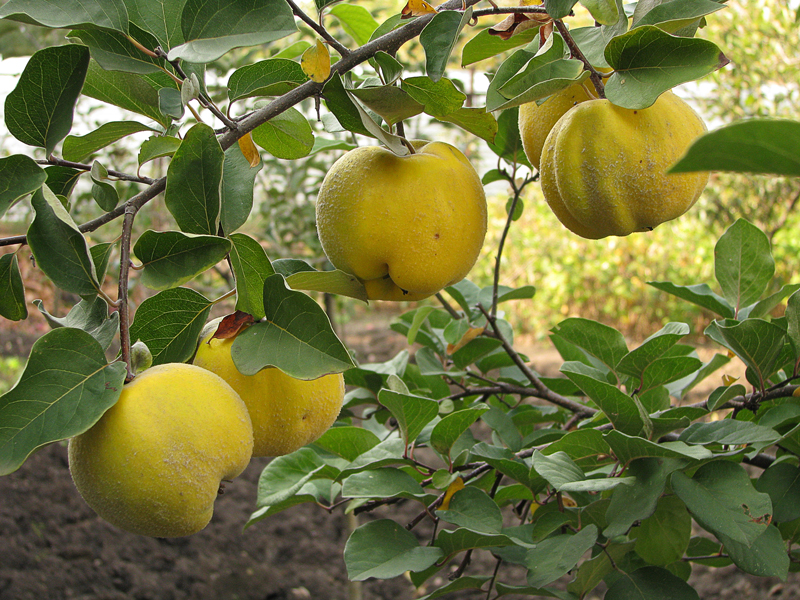
An excellent pupil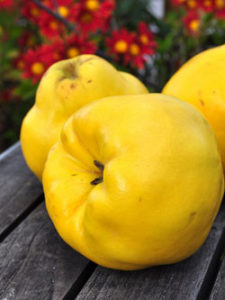
The variety was obtained by employees of the Nikitsky Botanical Garden. The tree is medium-sized, with a lush crown. On nutritious soils, it gives consistently high yields - 45 kg per tree. The plant tolerates low temperatures and drought well. An important condition for growing is abundant watering. Compliance with this simple rule increases the yield by 1.5 times. Productively bears fruit for 27 years. Quince ripens in early October. Stored for 80 days.
Golden
Weak variety. Branches are thin, intertwined. The crown is spherical. Fruit weight varies from 200 to 400 grams. Quince resembles an apple, the fluff on the surface is weak. The pulp is creamy, tough. Harvesting can begin at the end of September. One tree gives 30-40 kg.
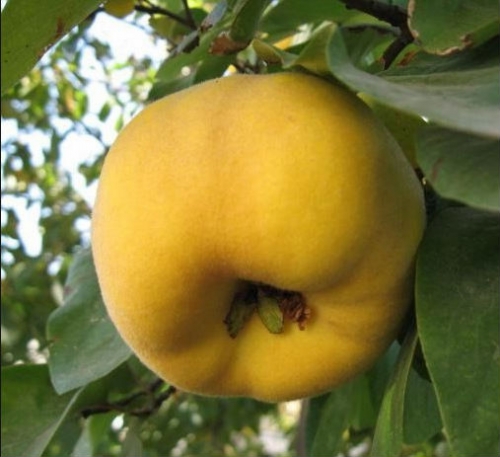
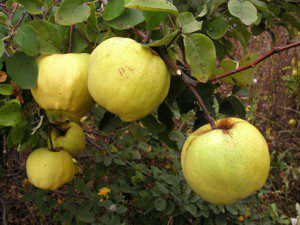 Crimean early
Crimean early
A variety that begins to bear fruit from 3 years of age. The tree is of medium height, with a round crown. Quince is bright yellow, smooth. It ripens at the end of September. The taste is tart, sweet and sour. Poorly tolerates long-term transportation. When transported over long distances, each fruit is wrapped in paper. The yield is at a good level - up to 40 kg per tree.
Kuban yielding
As the name implies, the main advantage of the variety is its yield. One tree gives up to 100 kg of fruit. At the same time, the quince is of excellent quality.
Large, juicy, aromatic, sweet and sour. The pulp is a little rough, creamy. Fruit mass - 500 gr. It tolerates low and high temperatures well.
The variety is resistant to pests. The fruits ripen at the end of September. Stored for a long time without loss of presentation.
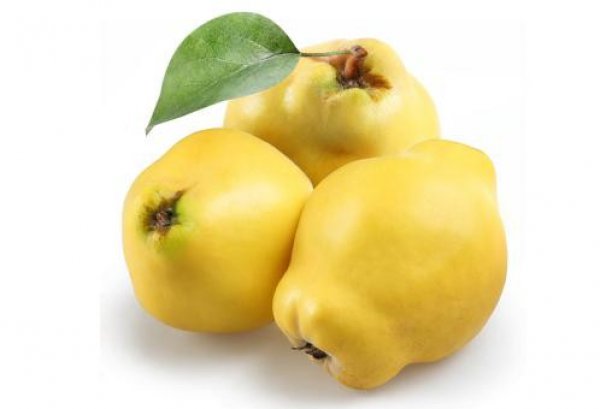
Muscat
Medium-sized variety, unpretentious in cultivation. Easily adapts to environmental conditions. Grows successfully even on compacted, scarce soils. He is not afraid of frosts and prolonged drought.
Nutmeg quince has a strong immune system - it rarely gets sick. Fruits are of medium size, weight - up to 250 gr. Quince is covered with a dense fluff, similar to felt. The pulp is light beige, fibrous, harsh. The taste is pleasant, sweet with a pronounced sourness.
One tree produces 35-45 kg of fruit. They ripen in September-October.
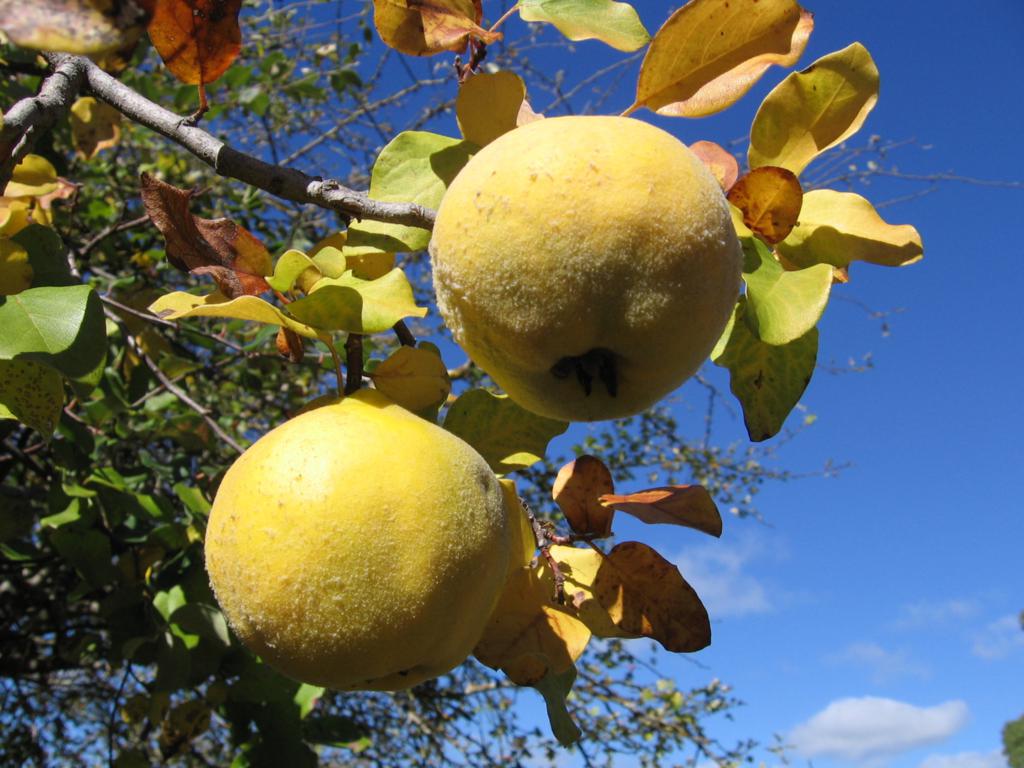
Rumo
This variety is a favorite of many gardeners. A medium-sized tree is characterized by winter hardiness and disease resistance. The fruits are large. In some cases, the mass reaches 600 grams.
Quince has an oval shape and juicy flesh. Taste - sweet and sour, without astringency. The harvest begins at the end of September. Productivity - 65-70 kg per tree.
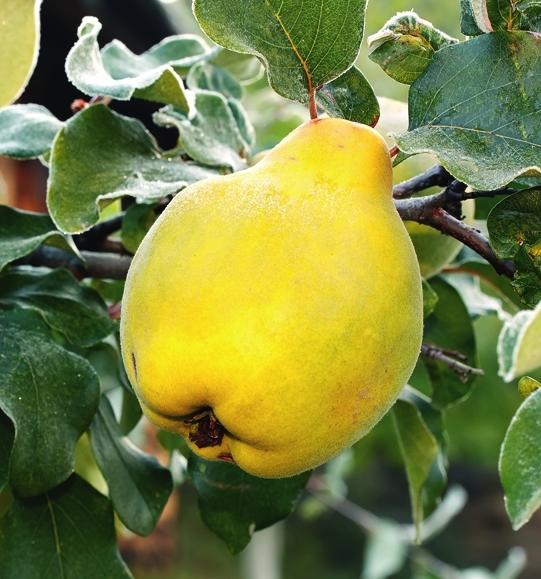
Kaunchi-10
Differs in high consumer qualities. A medium-sized tree produces beautiful pear-shaped fruits. Weight varies from 200 to 400 gr. The pulp is juicy and sweet. Ripening occurs in the first decade of October. Quince can be stored for up to 90 days. It is quite possible to collect from 50 to 60 kg from each tree.
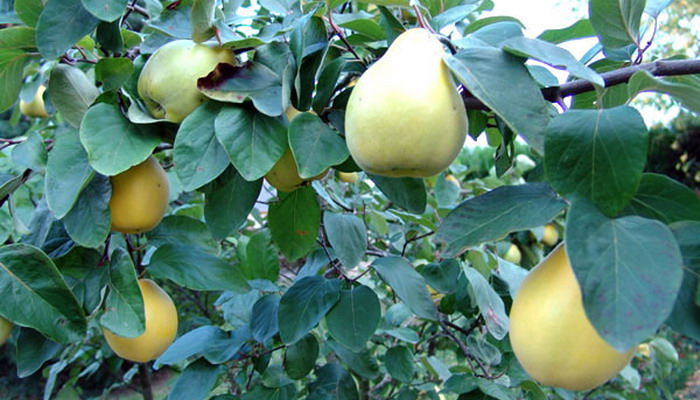
Teplovskaya
The variety was obtained in Astrakhan. The breeders wanted to develop a quince that is resistant to low temperatures and yields good yields. They succeeded. The tree is not afraid of cold weather. Produces yellow fruits resembling apples. Sizes are different - from small to large. The pulp is juicy, dense, aromatic. The taste is sweet and sour. Stored up to 4 months.
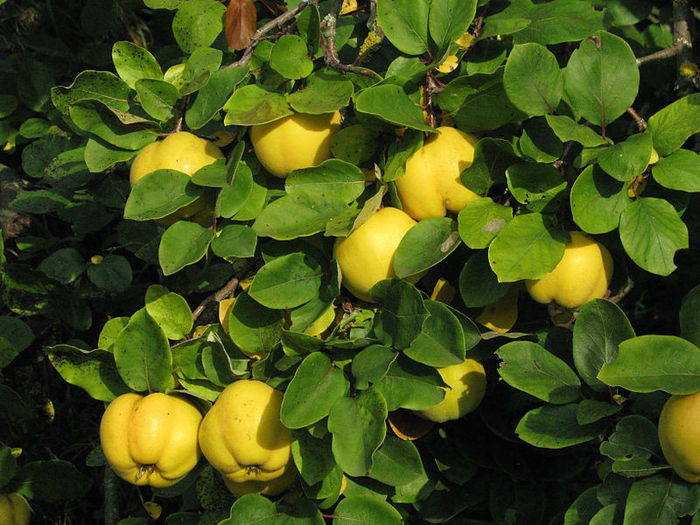
Here are 10 of the best varieties. Everyone is the perfect candidate for growing. They are resistant to low temperatures and drought, are practically not affected by fungi, give juicy and tasty fruits that are distinguished by high commercial qualities and can be stored for a long time.
Video review of quince, harvesting
These unusual fruits, in which rose, lemon and apple are combined, are infrequent guests in our gardens. Although with proper care, they will not yield to others in any way
fruit trees
.
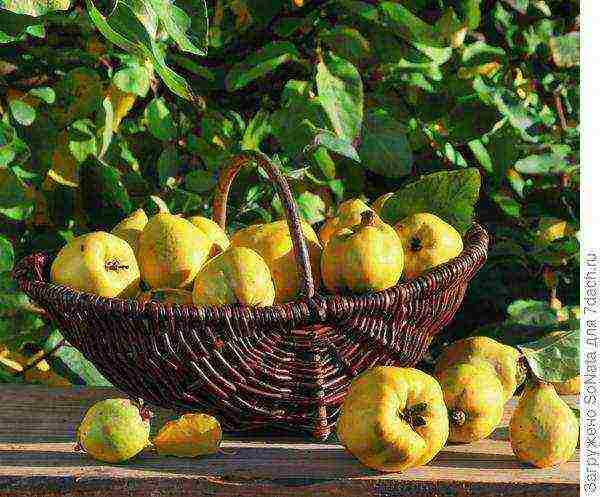
Quince
(Cydonia) like
Apple tree
with
pear
, belongs to the pink family (Rosaceae) - we can say that they are sisters. To understand this, just look at their equally large snow-white or pale pink flowers.
Quince flowers open only when the danger of return frosts has long passed, therefore, even if the spring was cool, nothing threatens the harvest.
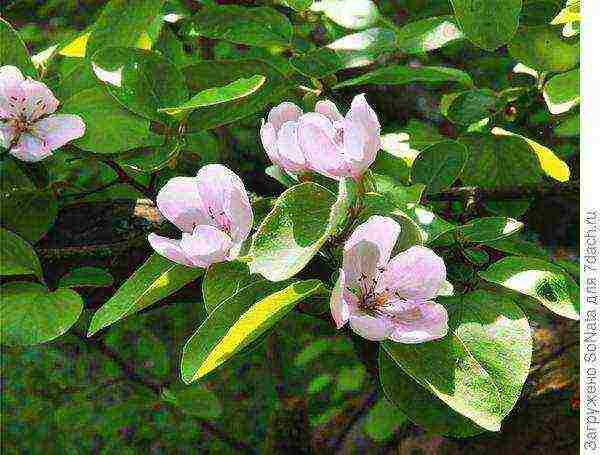
Ay yes quince
This fruit was highly valued in antiquity, and quince is grown no less four thousand years... She was well known to the ancient Greeks and Romans, who helped her advance to Northern Italy, France and other Western European countries. In England, for example, in the Middle Ages, baked quince was served at gala receptions as an exquisite dessert dish. And in the 17th-18th centuries, together with immigrants from Europe, she went on a journey around the rest of the world, including America and Australia.
And today it is grown in more than 40 countries, albeit mainly in private gardens, while large plantations are available only in the USA, Mexico, Australia and some European countries, for example, in Germany.
Since time immemorial, this southern culture has been known in the Transcaucasus, including the North Caucasus region of Russia, and Central Asia. But now the quince is successfully "moving" to the north, of course, only to places with a temperate climate. You can already see it with your own eyes in Sweden and Norway, and in Russia - in the Volga region and the Central Black Earth zone (Saratov, Samara, Voronezh, Tambov regions). Moreover, each region has its own varieties: in the Volga region - ‘Skorospelka’, ‘Maslenka Pozdnaya’, ‘Anzherskaya’, ‘Krasnoslobodskaya’, ‘Teplovskaya’; in Dagestan - ‘Vraniska Daniya’, ‘Gurdzhi ayva’, ‘Ktyun-Zhum’, ‘Buinakskaya large-fruited’, ‘Zabutlinskaya’; in the Krasnodar Territory - ‘Muscat’, ‘Yantarnaya Krasnodar’, ‘Kubanskaya’, ‘Zolotistaya’ and others.
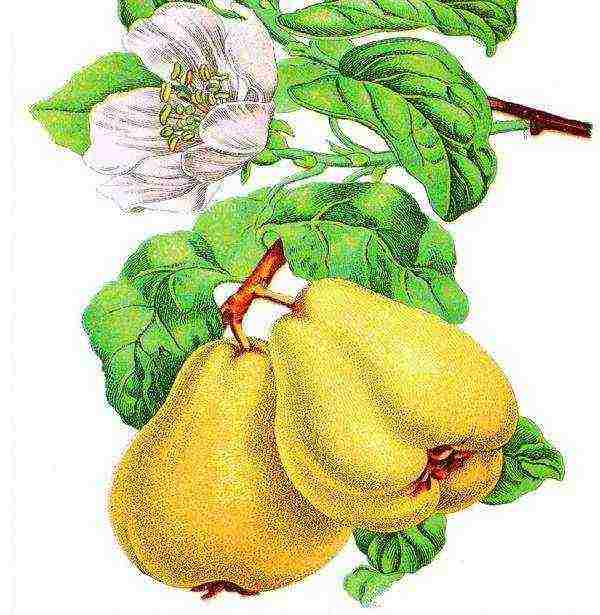
The advantages of quince
Compared to apple and pear, quince has a number of advantages. She:
- weak (it can even be formed in the form of a bush), which greatly facilitates the collection of fruits;
- blooms later, therefore, leaves from late spring frosts;
- early ripening and very fruitful.
In terms of winter hardiness, our "southerner" is, of course, inferior to apple and pear trees, but not too harsh winters endure quite easily. Damage - freezing of annual shoots - occurs only at temperatures below -37 ° C, but the plants then quickly recover.
But in comparison with its cold-resistant "sisters", quince is more drought resistantbesides, she can grow even on saline soilsthat rarely any culture can withstand. And on fertile and moist soils, the yield of quince reaches a maximum - more than 100 kg of fruits from one tree!
Harvest starts at the end of September and lasts until about the end of October, depending on the quince variety and weather conditions. The fruits are picked one at a time and placed neatly in fruit crates for storage.
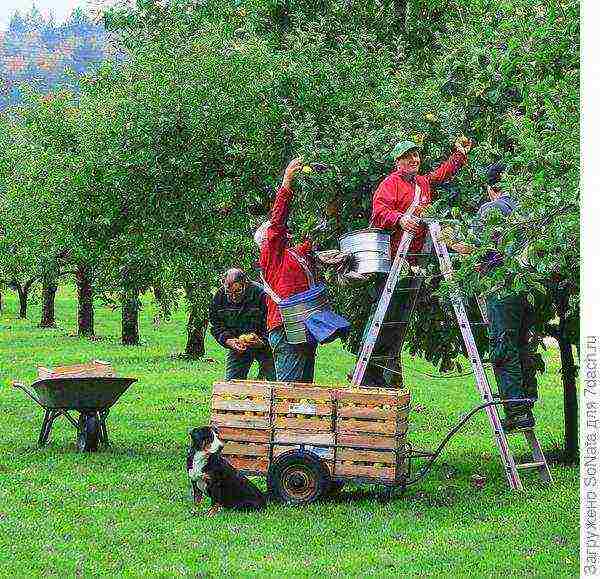
The perfect moment to harvest - shortly before full ripening, as soon as the green color of the skin of the fruit turns into yellow or lemon.
Useful properties and application
Quince fruits not only have an incomparable aroma, but are also considered a valuable dietary product. They are rich in substances useful for human health, such as organic acids with a predominance of apple and citric, sugar (mainly fructose and glucose), vitamins (C, group B, PP, etc.), pectins and minerals.
The healing properties of quince are also known. The fruit is recommended for indigestion as a wonderful astringent, and the seeds as an anti-inflammatory, emollient and mild laxative. A decoction of seeds is considered a good cosmetic product for skin care, is used to gargle with sore throat and as a lotion on the eyes.
For food quince is best consumed after processing. At home, you can use it to make aromatic jams, compotes, juices, jellies, jam, marmalade, candied fruits, pie filling and much more (see recipes in No. 4 of our magazine on pages 44-47). Baked, steamed and pickled quince is especially tasty and healthy: its pulp in this case becomes more juicy and tender, and the astringency almost completely disappears.
Fruit dessert varieties (‘Sovkhoznaya’, ‘Krasnoslobodskaya’, ‘Ilmenskaya’, ‘Dessertnaya’, ‘Portuguese’, etc.) are also used fresh. You can even dry and freeze them. For this, apple-shaped quince is more suitable.
Generally, by the shape of the fruit common quince (Cydonia oblonga) - this is the only type of quince in the culture - is divided into two varieties: round apple fruit (C. oblonga maliformis) and with oblong pear-shaped (C. oblonga piriformis).
In rounded fruits, resembling an apple, most often hard and very aromatic flesh, penetrated with numerous hard stony cells.
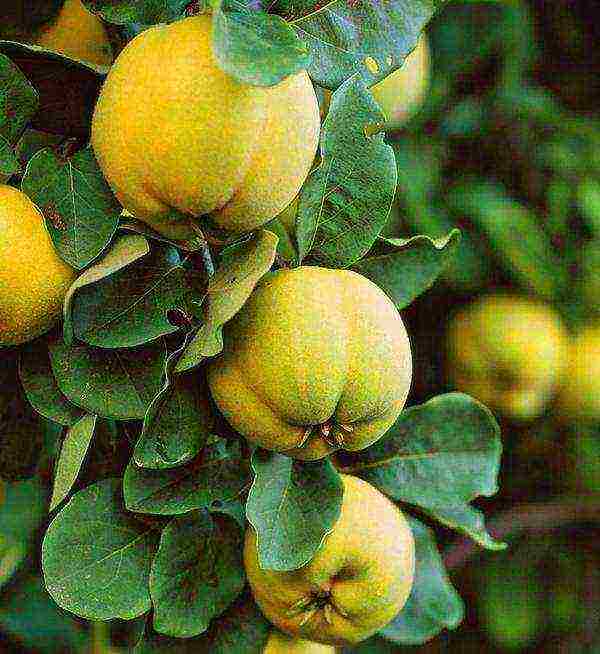
Pear-shaped fruits softer and sweeter in taste. Interestingly:for food use it is better to take quince after 4-8 weeks of storage, when it acquires a characteristic taste and aroma. At the same time, the content of "bad" tannins in the fruits decreases and the amount of "good" organic acids and pectin increases.
Do not forget and
about the decorative properties of quince ... Blooming trees with fruits are a great decoration for a small garden, as well as for a park or square. In addition, this plant is reliable - durable and unpretentious, requiring almost no maintenance. The branched root system of quince strengthens the slopes and slopes well.
And one more wonderful property of quince. In many countries, including Russia, it is widely used as rootstock for pear... Seedlings are grown from seeds and a varietal pear is grafted onto them with an eye or cuttings. This grafting gives the pear a short stature and accelerates the onset of fruiting.
Low growth of some varieties of quince - its great advantage. Harvesting quince is easier than the fruits of other fruit trees, and the yield under favorable weather conditions can reach up to a centner from one tree! 
In the nurseries of trees easier to care for and protect them from the fire, which is very afraid of quince.
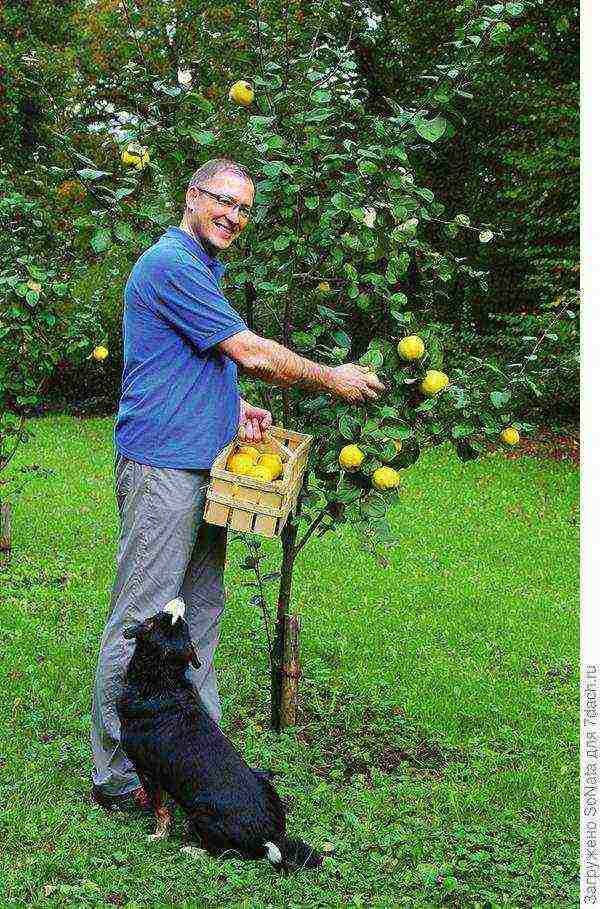
favorite varieties
Constantinople apple
Presumably a native of Turkey. Sour pulp with stony cells and the skin is golden exude a distinct aroma. If the fruit are harvested in the season from the beginning to the end of October, they can be stored until the end of December.
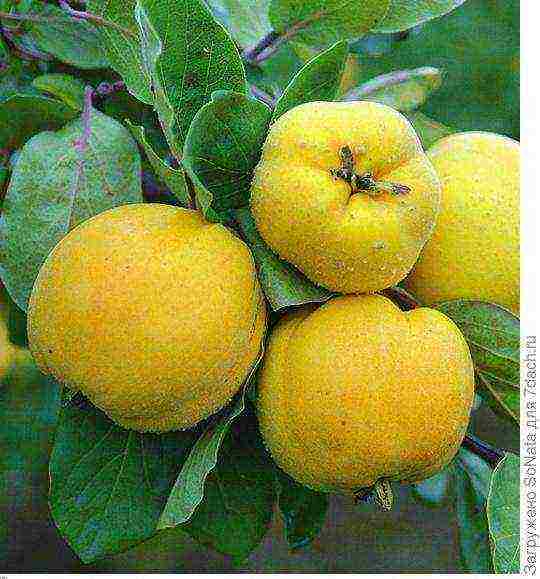
The giant from Leskovac
Gigantic quince from Leskovac more than one hundred years, the brand comes from Serbia and gives fruit weight of 200-500, the smooth surface is only slightly covered with fuzz. Unlike most other varieties have 'Leskovac' pulp and juice of the fruit does not turn red when cooked, and are pale yellow.
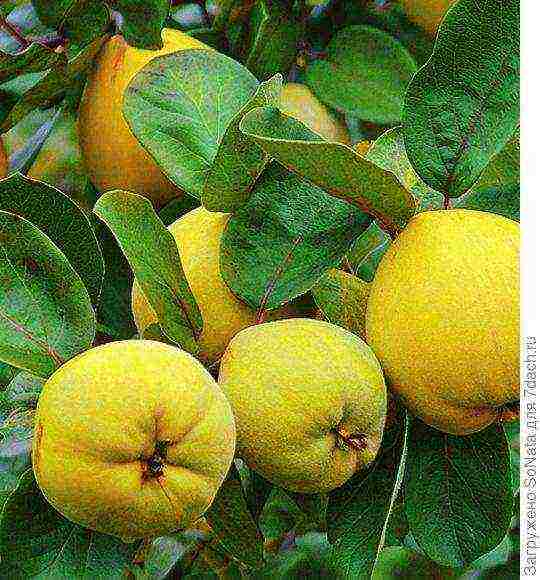
Champion
Pear-shaped quince, grown for the first time in North America in 1870 and is considered to be superior in taste and aroma. The flesh becomes brown even when fully ripe, the fruits ripen all at the same time, have the same size and each weigh 300 to 400 g
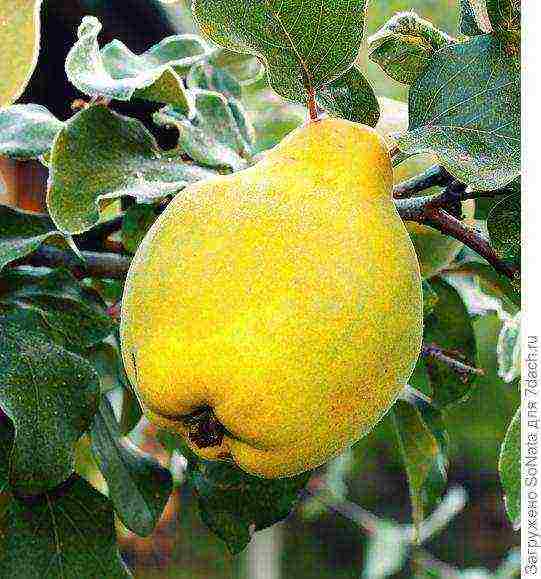
lies
Trees varieties 'Vrana' tall by nature, so they need regular pruning to reduce height. Grade this - good pollinator, so it is often used for replanting to other quince cultivars. Thick skin pear-shaped angular fruit layer is covered with a velvety gun.
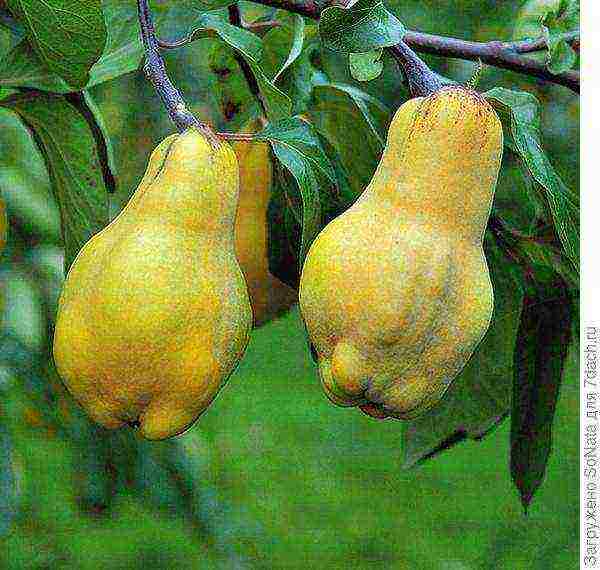
From golden autumn cooked fruit jam, and carefully manufactured by cold pressing juice processed into jelly or frozen for further preservation. after heat treatment tart and sticky fresh quince display their best flavor.

The most unusual recipes for quince read in the magazine "Country. Style and way of life »№4.
Quince known to people for many centuries, so it is the scientific classification changed with the development of botany and taxonomy improvement. The plant was transferred successively from one kind to another, it initially with apple, pear, Pyrus rowan belonged to genus or pear, then was isolated as a separate genus Pyrus japonica, or Japanese pear.
It also includes time species: japonica, or chaenomeles, quince and quince Chinese evergreen or dotsiniya. All of these plants have a number of common characteristics: polyspermous fruit pulp with hard stony structure and specific enough strong flavor, but also many differences exist between them.
Therefore, in 1822, English scientist Lindley Japanese quince allocated in a separate genus, named Chaenomeles, and the genus was named Quince Cydonia. Chinese quince at different times apply to the Chaenomeles, and Of Cydonia, until finally at the end of the XIX century it was not in a separate monotypic genus Pseudocydonia, as well as quince evergreen, referred now to Docynia old.
Thus, according to modern classification, genus quince (Cydonia) is a monotype. It consists of a single species - common quince (C. Vulgaris Pers), or another name - quince oblong (C. Oblonga Mill.).
classification of varieties
quince ordinary
View common quince can be divided into 5 groups of varieties or garden, different shape of fruits and some other biological features.
Two of them - the variety of ornamental quince: marble (f marmorata.), Whose leaves mottled surface, covered with white and yellow spots, and pyramidal (f pyramidalis.), Wherein a pyramidal crown.
The remaining three groups are garden quinces are grown to produce fruits and distinguished by their shape. This pear-quince (f pyriformis or typica.), With a pear fruits; apple-eminent (f maliformis.), with round similar to apple fruits; and Portuguese (f. lusitanica), which are fruits of pear-shaped rib.
Decorative quince
All varieties of ornamental quince are characterized by high resistance to drought, unpretentious to the soil, can grow in the dusty and gassed.
Plants tolerate a haircut and trim, allowing the crown to give the desired shape, very decorative in the spring, because the bloom spectacularly and long (about 3 weeks), and in the autumn, when the tree is decorated with long red deciduous leaves and bright yellow fruits.
These qualities make the culture of a very promising not only for decorative garden, but also for urban greening.
Gardening quince
Garden quince grown as a fruit tree has about 400 varieties, of which 39 are cultivated in our country.
They differ in winter hardiness, yield, disease resistance, shelf life, taste and size, as well as a number of other biological characteristics.
There are several main characteristics by which they are classified, usually the ripening period, the shape of the fruit and crown, and habit.
Pear-shaped quince
So, according to the ripening time, early (they form a harvest in 115-127 days after the end of flowering), medium (130-136 days) and late (141-152 days) varieties of quince are distinguished. According to the shape of the fruit, they are divided into apple-shaped and pear-shaped.
The varieties of apple quince are considered more early ripening, and pear-shaped ones are more juicy and sweet. Some authors distinguish a larger number of fruit shapes: spherical, apple-shaped, elliptical, pear-shaped, cone-shaped and convex-cone-shaped.
By the type of crown, trees can be divided into pyramidal, wide-pyramidal and spherical. Finally, according to their habit, vigorous, medium-sized and low-growing plants are distinguished.
The most common varieties of quince
Since the area of cultivation is limited by average annual temperatures from 8 to 9 ° C and an absolute minimum of minus 15 ° C, on the territory of Russia most varieties are zoned for the North Caucasus region and the Lower Volga region (Astrakhan and Volgograd regions).
In neighboring states, the plant is also grown on the territory of Ukraine (Crimea, Odessa region and Transcarpathia), in Azerbaijan, Tajikistan and Uzbekistan.
Recently, a number of winter-hardy varieties have appeared that make it possible to cultivate quince much north of the usual area, in the Baltic States, Belarus and the Tambov region.
The most common early quince varieties:
Muscat, zoned for the North Caucasus region, with a pyramidal crown, rounded fruits of medium size (up to 200 g), smooth or slightly ribbed, with weak pubescence. The pulp is juicy, fine-grained, of good taste. Self-fertile, early fertile.
Gold of the Scythians, a high-yielding zoned variety, with rounded fruits of medium size (250 g), bright yellow, slightly pubescent. The pulp is juicy, of medium density, sweet and sour, with a strong aroma, recommended for growing in the North Caucasus.
Persian sugar, a local quince with pear-shaped fruits, common in the Volga region, as well as in Ukraine and Crimea.
Known early cultivars also include Blagodatnaya, Van Diemen, Fuller, Childs.
The group of popular mid-season varieties is more numerous:
Krasnoslobodskaya, recommended for cultivation in the Volga region and the Caucasus, is distinguished by its short stature and high yield. Large (up to 400 g) apple-shaped fruits practically do not have stony cells, their flesh is juicy, medium-dense and very aromatic.
Gurdzhi, zoned for Dagestan, with a spherical crown and apple-shaped fruits of an average (225 g) size. Technical purpose.
Ktyun Zhum, common in southern Dagestan, is one of the most vigorous and large-fruited varieties grown in the Caucasus. The crown is wide-rounded, the fruits reach 800 g, highly cylindrical, with tomentose pubescence.
The Kuban, Crimean variety, is also zoned for the Krasnodar and Stavropol Territories of Russia, the Caucasus and Moldova. Differs in early maturity, medium (170-250 g) fruits of the same size.
Krasnodar large-fruited, medium-sized, early-growing and winter-hardy, with large and very large fruits (average weight - about 400 g), pear-shaped, strongly ribbed, having a weak pubescence that is easily erased when ripe. It is resistant to diseases, has a canning and table purpose.
Teplovskaya, productive, medium-sized, zoned for the Lower Volga region. Fruits are apple-shaped, weighing 120-150 g, with strong pubescence and dense fragrant pulp.
Amber Krasnodar, grown in the Caucasus, medium-sized variety, distinguished by yield, early maturity, high quality of fruits and products of their processing.
Of late-ripening varieties, the following are popular among gardeners:
Zubutlinskaya quince of folk selection from Dagestan, zoned in the Caucasus, winter-hardy, resistant to diseases and strong winds, gives consistently high yields. Fruit weight reaches 800 g, they are well stored and transported.
Vraniska Denmark, country of origin - Yugoslavia, high-yielding, with fruits of medium and above average size (180-270 g), appreciated for high taste, wind-resistant, not affected by diseases. Distributed on the plains and in the foothills of Dagestan.
Jardam, zoned in Azerbaijan and Turkmenistan, has large pear-shaped fruits weighing an average of about 500 g, is used fresh and processed, stored for up to 5 months.
Fertile mitch, a variety of American selection, is widespread in Turkmenistan, the mass of pear-shaped fruits is about 500 g, they are distinguished by good keeping quality.
Golotlinskaya apple-shaped, grown in Dagestan, apple-shaped fruits weigh an average of 130 g, are stored for up to 4 months.
Late-ripening varieties also include Champion, Ahmed Zhum, Armenian Tursh.
In addition to the varieties officially entered in the register of individual countries, there are many other equally valuable cultivars of local origin.
Quince is one of the largest fruiting plants found in temperate climates. In some varieties, fruits weigh 2 kg or more (Papysh, Giant from Vranja, Giant from Leskovac), in others - 1 kg (Beretsky, Champion, Van Diemen, Monstrous from Bazin, etc.).
Separately, we note the frost-resistant northern quince, bred by I.V. Michurin by hybridizing the wild common quince and the semi-cultivated variety growing in the Volga region. It is very drought-resistant and more frost-resistant than the parent specimens.
It is interesting that the still grown and quite popular Portuguese quince is the oldest European variety, bred in ancient Rome.
Currently, a large selection work is underway to create plants with improved properties. So, a number of super-fast-growing varieties have been bred that yield a crop already a year after planting - Dessertnaya, Mir, Muse, Excellent student, Nakhodka, etc., and Yantarnaya, Selena, Canned late are not only early-growing, but also stunted. A valuable quality of new cultivars is self-fertility, which is possessed by Canning Late, Selena, Mir, Excellent, Firstborn and a number of others.
Photo gallery: quince varieties (click on the picture to enlarge):
Of course, with skillful care, the cultivation of quince is possible in medium-level conditions, however, the fruits of such trees are strikingly inferior to their southern relatives in quality.
What a quince looks like: a photo and description of the species and varieties of shrubs
Quince Is a very ancient culture that has been cultivated for over 4000 years. In ancient times, quince was known in Egypt, China, but the Caucasus and, mainly, Georgia, then Azerbaijan and Armenia are considered the center of its culture. Central Asia is almost not inferior to them, where there is no garden without quince. In Ukraine, Crimea and the North Caucasus, in the Astrakhan region, quince was brought from the South Caucasus.
Below you can familiarize yourself with the description and see a photo of the most common types of quince - common and Japanese.
Common quince. All wild quince of Asia Minor, Dagestan belongs to this species. Its varieties differ in the shape of the fruit - apple or pear-shaped.
This is a shrub or a low tree up to 2-3 m in height. The leaves are glabrous above, felted below, whitish.
As you can see in the photo, this type of quince has short leaf petioles, which makes them seem almost sessile:
The flowers are white-pink, solitary, on short pubescent pedicels. Blooms later than other breeds - in mid-May. Fruits are large, fragrant, firm, dark yellow in color. Ripen in October.This type of quince is winter-hardy and drought-resistant.
Japonica - homeland China and Japan, found in a wild form in the Mediterranean. This is a shrub with a height of 0.5 to 1.5 m.
Branches are erect, glabrous, leaves are elliptical, up to 8 cm long, sharp, with serrated edges. From above, they are shiny, dark green, leathery. Flowers are arranged in bunches of 2-6 on last year's wood. They are almost sessile, large, purple-red, varying to pink and white. Fruits can be spherical or ovoid, medium-sized (up to 5 cm), yellow or yellowish-green, very fragrant.
Japanese quince is photophilous, does not bloom in the shade and has no decorative effect. It has the same requirements for heat as the common quince, i.e. grows only in the south.
See what the Japanese quince looks like in the photo below:
Common quince fruiting occurs in the 4th-5th year. Shoots grow up to 4-10 cm, and then a large sessile white-pink flower appears at the top. The shoot stops growing after fruit set. If the fetus is not tied, the lateral bud awakens. The shoot from it grows intensively and for a long time, until autumn, ending with a mixed-type apical fruit bud.
Good to know:
- The constantly flaking bark of a fruit-bearing quince is normal.
- Quince is an excellent honey plant, from 1 hectare of quince garden bees collect up to 18 kg of honey.
- Quince bushes are relatively durable. They live up to 70 years, and bear fruit abundantly up to 50 years.
Next, you are offered a photo and description of the most popular varieties of quince shrubs.
"Aurora" - a high-yielding medium-sized variety. Fruits are yellow, large, ripen in early October. Shows high resistance to fungal diseases, tolerates drought well.
"Anzherskaya" - French variety, medium-sized and early-growing. The fruit is apple-shaped, the skin is smooth, lemon-yellow in color. The pulp of the fruit is dense, around the heart with granulations. They are used both for processing and for fresh consumption.
"Golden" - the trees of this quince variety are weak, with a rounded crown and thin hanging branches. Fruits are large (250-400 g), slightly pubescent, apple-shaped, ripen in the third decade of September. The pulp is creamy, sweet and sour. Harvest 40-60 kg per bush.
"Kubanskaya" - a low-growing variety.
Pay attention to the photo - this variety of quince has medium-sized fruits, round-cylindrical, in shape:
Fruits ripen in the first - second decade of October. The pulp is creamy, juicy.
"Muscat" - medium-sized variety. The fruits are large, with dense tomentose pubescence. This quince looks like "Kuban", but the fruit pulp is lighter, coarse. The fruits ripen in late September - early October. Harvest 30-45 kg per tree.
"Harvest Kuban" - medium-sized variety. The fruits are large (280-500 g). The pulp is creamy, juicy, sweet and sour, edible fresh. The fruits ripen in the second, third decade of September. Productivity - up to 100 kg per tree. The variety is winter-hardy and drought-resistant, not susceptible to fungal diseases.
"Amber Krasnodar" - medium-sized variety. Fruits are medium (120-200 g), apple-shaped, slightly ribbed. The pulp is creamy, sweet and sour. The fruits ripen in the second, third decade of September. Harvest 30-45 kg per tree.
Such varieties are also popular as:
- "Oil early",
- "Samarkand large-fruited"
- and "Khorezm apple-shaped".
How to grow quince and how to care for it
Quince blooms later than apple and pear, it is cross-pollinated, but does not differ in its selective ability to pollinator varieties.
How to grow quince on your garden plot? To get a good harvest of fruits in the garden, at least two quince bushes should be grown side by side.
Quince does not have a fruiting frequency, which compares favorably with other pome species. In terms of frost resistance, it is inferior to apple and pear. But because of the deep dormancy, quince buds are rarely damaged in winter. And only at -30 ° C frost can freeze all the buds.In spring, after such frosts, it hardly recovers.
Quince tolerates heat well if the temperature is combined with high relative humidity. It would seem that quince, as a thermophilic breed, should be afraid of autumn frosts, just when its fruits ripen. However, only frosts of -22 ° C can damage the fruits, and in this sense they can be equated with the resistance of rowan berries.
Quince is a light-loving breed. In the wild, it is found mainly in clearings, forest edges. It does not bloom in the shade, withers and may die.
Quince can do without water for a long time - 2-3 months. At the same time, it is able to withstand prolonged flooding. She is not afraid of nearby groundwater and soil salinization. But the fruits of quince with excessive moisture become woody and astringent, on dry soils they become smaller. With optimal soil moisture and high relative humidity, the fruits are sweet and aromatic.
Despite the unpretentiousness of quince to soils, its successful culture is possible only on rich light loams with high organic matter. Harvests are then annual and plentiful, but on fertile light soils, quince lives much less than on heavy ones.
In the process of caring for quince, it is necessary to apply organic fertilizers (manure, compost, peat) at the rate of 6-7 kg per bush. This is usually done in the fall.
For varieties of medium vigor, a feeding area of 3 x 3 m is sufficient.For vigorous varieties, this area can be increased to 4 x 4 m.
On heavy wet soils, in conditions of snowless winters and prevailing dry winds, quince should be planted in spring. And only in a mild climate, autumn plantings are preferable.
The row spacing of the garden for quince can be tinned, but the trunks should always remain clean of weeds, loose and mulched - best with humus.
Care and growing of quince: pruning and propagation by cuttings (with photo)
It is necessary to prune quince annually, shortening only one-year growth. First of all, you need to properly form a young plant. The length of the pruning depends on the vigor of the shoot. If the shoot is 40-50 cm, it is shortened by 1/3, at 75 cm - more than half. With this pruning, the bush turns out to be low, and therefore the quince suffers less from dry winds.
To enhance fruiting at maturity, young shoots are systematically pinched. And if the pruning of branches is done in early spring, then the pruning is done in the summer and is repeated several times during the season. The consequence of such a pinching is the formation of fruit buds.
The photo "Leaving and growing quince" shows how to properly prune and pinch branches:
Reproduction of cultivated quince is carried out by budding and cuttings. Quinces are circled on its own wilds grown from seeds. Seeds taken from the fruit are sown immediately, because they cannot stand drying out. In a year, seedlings grow, ready for budding, which is produced at the time usual for apple and pear. The survival rate is generally good.
Propagation of quince cuttings is much easier. Woody annual cuttings take root better. They are harvested in the fall after leaf fall, when the sap flow has stopped, and are placed in the sand in the basement, where they remain all winter. Callus forms by spring. In this state, the cuttings are planted in the ground. The optimum length of the cuttings is 20-30 cm. They are immersed in the soil, only 2 eyes remain on the surface. The inclined or vertical planting of the cutting does not matter.
Good to know:
- The fruit must be kept on the tree until fully ripe. The picking time is determined by the partial or complete cleansing of the fruit from the felt pubescence. They turn yellow and easily detach from the branch.
- Fruit harvesting is a very delicate process. Even light bruises cause dark spots and negatively affect keeping quality. The fruits rot. High-quality fruits can last until February - April.The optimum storage temperature is + 1.5 ... + 2 ° С.
Why is quince useful for the body and how to use it
The fact that quince is useful for the body was well known even in the days of Ancient Egypt, because it was not these woody plants that were so widespread.
Quince fruits contain from 5 to 12% sugar (glucose, fructose, sucrose), organic acids (malic, citric). They contain a lot of pectin and tannins, iron (30 mg / kg), copper (14 mg / kg) and vitamin C (about 20 mg%), as well as essential oil.
The seeds contain up to 20% mucus, fatty oil, starch. These useful properties of quince give reason to use them in pharmacology.
In ancient medicine, quince was considered a good remedy for indigestion. Specially prepared quince juice with honey and vinegar was recommended for stimulating appetite, “strengthening the stomach” and for “weak liver”. For a long time, the fruits of quince have been used in their natural form and in the form of decoctions for diarrhea and bleeding. The beneficial properties of quince fruits allow the use of these fruits in the manufacture of diuretics, as well as in the production of drugs for dropsy. Quince seed tea is recommended for coughing.
What else is quince useful and how is it used in traditional medicine? In many countries, compotes and quince jam are used for gastrointestinal diseases, to improve the functioning of the digestive tract. Grated boiled fruits are also used for liver diseases, as an antiemetic.
But fresh quince is almost never used because of the large amount of tannins. But there are local varieties, the fruits of which are very sweet and not tart. They are used fresh and as a seasoning for various national dishes.
An iron-containing extract is prepared from fresh quince, which is used for anemia and other diseases. For medicinal purposes, mature quince seeds are also used. In water, the seeds give a large amount of indifferent mucus, which is used for burns and skin irritations.
Useful properties of quince for the body, aroma, abundance of sugars, peculiar fruit consistency, color, and most importantly, late ripening make quince valuable for making jams, jams, marmalades, candied fruits at convenient times, when the summer-autumn fruit and berry conveyor ends.
Cosmetologists can tell you how else to use quince, because cleansing lotions, creams and masks for the care of the face and hands are prepared from this valuable fruit.

